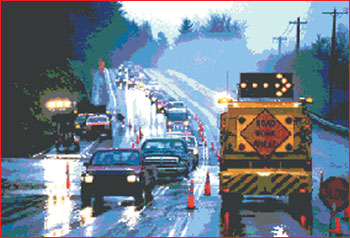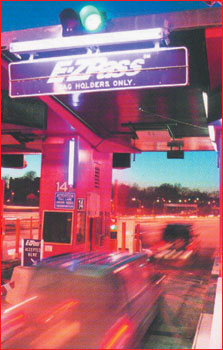Key Freight Transportation Challenges
Operations
Freight operations are the practical work of moving goods from a shipper to a receiver, a subset of activities that constitute logistics (or supply chain) management. In the United States, the private sector is responsible for most freight operations. The public sector also has a role in freight operations through its ownership and management of the Nation's highway system, ports, and inland waterways, and its regulation and taxation of freight movement.
The pressure on carriers to improve operations comes not only from the growth in freight movement but also from the need for new logistical arrangements and the demand for smaller more frequent shipments where reliability is particularly important. In the near term, capacity shortfalls and congestion may not shut down the Nation's freight network, but they can degrade the predictability and reliability of freight service. Reliability and predictability are a shipper's most important criteria for freight transportation in an era of tightly integrated operations, limited inventory, and just-in-time manufacturing and retailing.
Over the past two decades, freight operations have expanded and improved across all modes as a result of several factors, including deregulation, increased vehicle capacity, globalization of the economy, and collaborative logistics. Since the late 1970s, economic deregulation has resulted in a massive restructuring and reorganization of the freight industry and huge gains in productivity. Today, the freight services industry is seeing diminishing returns from deregulation and there are few remaining opportunities for further deregulation. Still, some productivity improvements are expected from the development of new alliances and pooling arrangements. However, the industry will probably not see similar vehicle size and capacity increases in the next decade, except perhaps in mega-containerships.
As a result, emphasis is now
being placed on better management of public facilities and the use of
intelligent transportation system (ITS) technologies. These will be particularly
important in the new environment of increased emphasis on security and
safety and the push for increased information and visibility in the transportation
process.

FHWA
is working to enhance the operational
efficiency and safety of highway work zones
for all road users and workers. Source: FHWA, Office of Transportation
Operations
In highway and trucking operations, for example, ITS technologies are used to monitor traffic and provide information to travelers about work zones and incidents. The first incident management programs focused on metropolitan facilities (e.g., beltways), but FHWA and state DOTs have expanded the program to include intercity corridors. Many states and metropolitan areas have also introduced electronic tolling at bridges and tunnels, increasing speeds and reducing congestion in the process. To manage these and other initiatives, many metropolitan areas have set up traffic operations centers.
In the railroad industry, new technologies, such as positive train control, have shown promise in improving rail operations. To increase the efficient utilization of assets, railroads are also pursuing equipment sharing agreements and pooling arrangements. And, in the maritime industry, operational improvements have come from the introduction of technologies, such as terminal management systems that can locate all terminal equipment and containers. An example of this is the Port of New York/New Jersey's web-based Freight Information Real-Time System for Transport. The system will consolidate various sources of cargo and carrier information, including cargo availability and gate and shipment status.

To
help reduce traffic congestion, five transportation agencies in DE, NJ,
and NY use the E-Z Pass technology to collect tolls electronically. Source:
I-95 Coalition
Although many successes have been realized, some challenges to improving operations remain. The world of intermodal freight, for example, is fragmented by the presence of numerous stakeholders who have different priorities. These differences can create "islands of information" that result in barriers to data exchange. The lack of accurate and timely shared information about shipment location, vehicle and equipment availability, gate queues, and highway congestion increases costs and undermines reliability and productivity across the intermodal system. Hence, the flow of accurate and timely information through the freight system is just as important today as the movement of freight. Indeed, information provides the thread that binds individual operations into an efficient intermodal system and, therefore, is an important area of focus for both the public and private sectors.
Unfortunately, optimization of the transportation system over the past 25 years has resulted in little or no excess capacity or redundancy. Vastly more freight is being moved by rail with fewer miles of railroad and fewer rail cars and locomotives. As noted earlier, excess capacity is gone from many parts of the rail network. As a result, operations have become more vulnerable in the event of breakdowns or other unforeseen events, such as storms, accidents, and congestion. The lack of redundancy reduces the number of options available to shippers, decreases competition, and makes prices more volatile. The vulnerabilities are more acute with the development of coordinated logistics systems that are cost effective for shippers and receivers, but place tremendous strains on the transportation system in terms of demand and reliability.
Heightened security may pose another challenge to improving freight operations, particularly at ports of entry. From now on, security needs will be an important consideration in designing new systems to enhance operations and upgrading existing ones.
Clearly, more efficient operations are essential to optimizing national freight performance, expanding system capacity, and mitigating the effects to natural resources, neighborhoods, and people. Operations improvements cannot obviate the need for investment in new capacity in many locations. However, it is an essential cost effective element for freight productivity and security.
previous | next